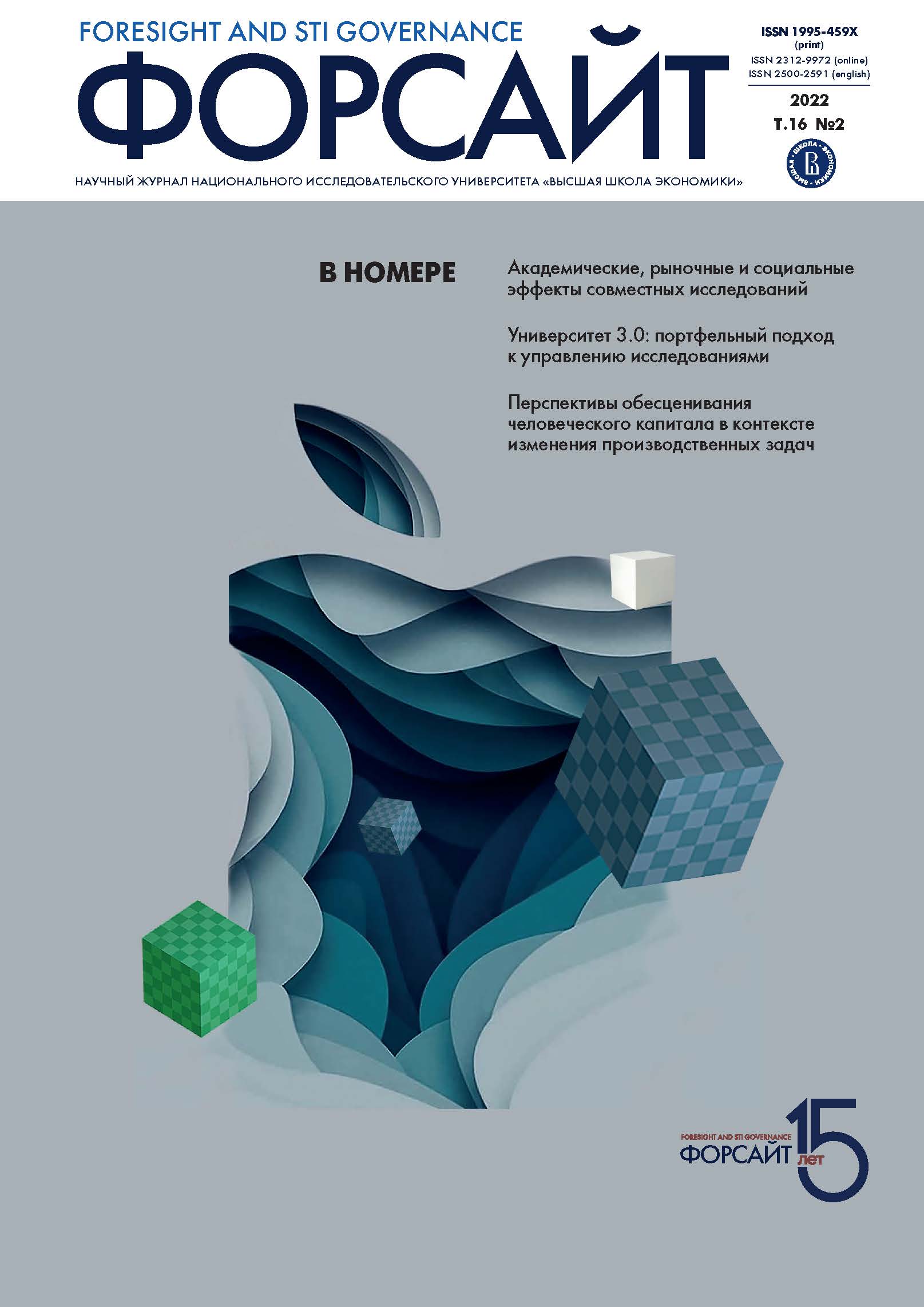Аннотация
В статье анализируется зависимость амортизации человеческого капитала от характера производственных задач и уровня образования. Исследование основано на панельных данных социально-экономической статистики Германии, обработанных с помощью регрессионной модели с фиксированным эффектом, расширенного уравнения Минсера и модели Неймана-Вайса. Выяснилось, что наибольшей амортизации подвержен человеческий капитал, основанный на высшем образовании. Ряд специальных навыков устаревают быстрее, чем компетенции общего характера. Вклад образования в повышение производительности наиболее интенсивно обесценивается на высокотехнологичных рабочих местах, характеризующихся значительной долей нестандартных интерактивных и ручных, а также стандартных когнитивных задач. Представленные результаты указывают на необходимость разработки комплексной политики по противодействию амортизации человеческого капитала. Учебным заведениям всех уровней следует усилить акценты на формировании универсальных навыков и адаптировать образовательные программы с учетом быстрого обновления производственных технологий и меняющихся требований к компетенциям.
Литература
Arrazola M., Hevia J.D. (2004) More on the estimation of the human capital depreciation rate. Applied Economics Letters, 11(3), 145-148. DOI: https://doi.org/10.1080/1350485042000203742
Autor D., Dorn D. (2013) The Growth of Low-Skill Service Jobs and the Polarization of the US Labor Market. American Economic Review, 103(5), 1553-1597. DOI: https://doi.org/10.1257/aer.103.5.1553
Autor D., Handel M. (2013) Putting tasks to the test: Human capital, job tasks, and wages. Journal of Labor Economics, 31(S1), S59-S96. DOI: https://doi.org/10.1086/669332
Autor D., Levy F., Murnane R.J. (2003) The skill content of recent technological change: An empirical exploration. The Quarterly Journal of Economics, 118(4), 1279-1333. DOI: https://doi.org/10.1162/003355303322552801
Backes-Gellner U., Janssen S. (2009) Skill obsolescence, vintage effects and changing tasks. Applied Economics Quarterly, 55(1), 83-104. DOI: https://doi.org/10.3790/aeq.55.1.83
Becker G. (1964) Human Capital, New York: Columbia University Press.
Carliner G. (1982) The wages of older men. Journal of Human Resources, 25-38. DOI: https://doi.org/10.2307/145522
De Grip A. (2006) Evaluating human capital obsolescence, Paris: OECD. https://www.oecd.org/els/emp/34932083.pdf, accessed 25.03.2022.
De Grip A., Van Loo J. (2002) The economics of skills obsolescence: A review, Bingley (UK): Emerald Group Publishing Limited.
Dengler K., Matthes B., Paulus W. (2014) Occupational tasks in the German labour market (FDZ-Methodenreport 12/2014), Berlin: Institute for Employment Research. https://doku.iab.de/fdz/reporte/2014/MR_12-14_EN.pdf, accessed 24.02.2022.
Frey C.B., Osborne M.A. (2017) The future of employment: How susceptible are jobs to computerisation? Technological Forecasting and Social Change, 114, 254-280. DOI: https://doi.org/10.1016/j.techfore.2016.08.019
Groot W. (1998) Empirical estimates of the rate of depreciation of education. Applied Economics Letters, 5(8), 535-538. DOI: https://doi.org/10.1080/135048598354500
Haley W.J. (1976) Estimation of the earnings profile from optimal human capital accumulation. Econometrica: Journal of the Econometric Society, 44(6), 1223-1238. DOI: https://doi.org/10.2307/1914256
Heckman J.J. (1976) A life-cycle model of earnings, learning, and consumption. Journal of Political Economy, 84(4, Part 2), S9-S44. https://www.jstor.org/stable/1831101.
Holtmann A. (1972) On-the-job training, obsolescence, options, and retraining. Southern Economic Journal, 38(3), 414-417. DOI: https://doi.org/10.2307/1056910
Johnson T., Hebein F.J. (1974) Investments in human capital and growth in personal income 1956-1966. The American Economic Review, 64(4), 604-615. https://www.jstor.org/stable/1813313.
Lentini V., Gimenez G. (2019) Depreciation of human capital: A sectoral analysis in OECD countries. International Journal of Manpower, 40(7), 1254-1272. DOI: https://doi.org/10.1108/IJM-07-2018-0207
Mincer J. (1974) Schooling, Experience, and Earnings, Cambridge, MA: NBER.
Mincer J., Ofek H. (1982) Interrupted work careers: Depreciation and restoration of human capital (NBER Working Paper 0479), Cambridge, MA: NBER. DOI: https://doi.org/10.3386/w0479
Murillo I.P. (2011) Human capital obsolescence: Some evidence for Spain. International Journal of Manpower, 32(4), 426-445. DOI: https://doi.org/10.1108/01437721111148540
Muro M., Liu S., Whiton J., Kulkarni S. (2017) Digitalization and the American workforce. Washington, D.C.: Brookings Institution. https://www.brookings.edu/wp-content/uploads/2017/11/mpp_2017nov15_digitalization_full_report.pdf, accessed 16.01.2022.
Neuman S., Weiss A. (1995) On the effects of schooling vintage on experience-earnings profiles: Theory and evidence. European Economic Review, 39(5), 943-955. DOI: https://doi.org/10.1016/0014-2921(94)00019-V
Ramirez J. (2002) Age and schooling vintage effects on earnings profiles in Switzerland. In: The Economics of Skills Obsolescence (eds. A. de Grip, J. van Loo, K. Mayhew), Bingley: Emerald Group Publishing Limited, pp. 83-99. DOI: https://doi.org/10.1016/S0147-9121(02)21006-7
Rodrigues M., Fernández-Macías E., Sostero M. (2021) A unified conceptual framework of tasks, skills and competences, Brussels: European Commission.
Rosen S. (1975) Measuring the obsolescence of knowledge, Cambridge, MA: National Bureau of Economic Research.
Spitz-Oener A. (2006) Technical change, job tasks, and rising educational demands: Looking outside the wage structure. Journal of Labor Economics, 24(2), 235-270. DOI: https://doi.org/10.1086/499972
Weber S. (2014) Human capital depreciation and education level. International Journal of Manpower, 35(5), 613-642. DOI: https://doi.org/10.1108/IJM-05-2014-0122

Это произведение доступно по лицензии Creative Commons «Attribution» («Атрибуция») 4.0 Всемирная.


